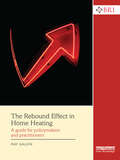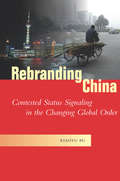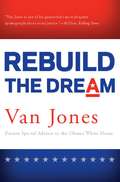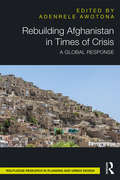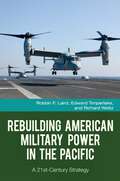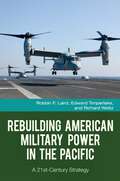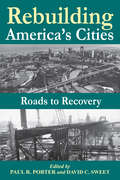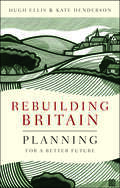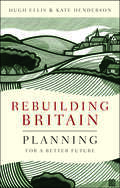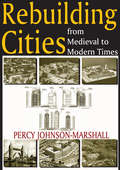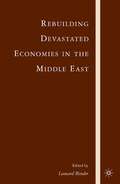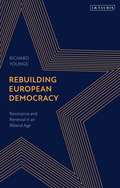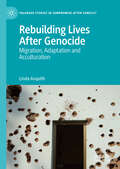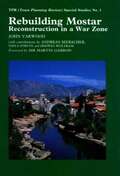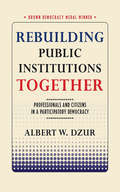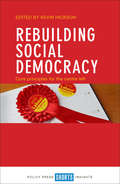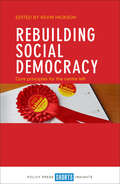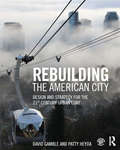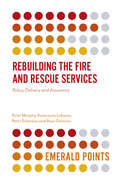- Table View
- List View
The Rebound Effect in Home Heating: A guide for policymakers and practitioners (Building Research and Information)
by Ray GalvinThis is a definitive guide to the rebound effect in home heating – the increase in energy service use after a technological intervention aimed at reducing consumption. It sets out what the effect is, how it plays out in the home heating sector, what this implies for energy saving initiatives in this sector, and how it relates to rebound effects in other sectors. The book outlines how the concept of the rebound effect has been developed and the scope of research on it, both generally and particularly in the home heating sector. Within the context of energy and CO2 emissions policy, it summarises the empirical evidence, exploring its causes and the attempts that are being made to mitigate it. Various definitions of the rebound effect are considered, in particular the idea of the effect as an energy-efficiency ‘elasticity’. The book shows how this definition can be rigorously applied to thermal retrofits, and to national consumption data, to give logically consistent rebound effect results that can be coherently compared with those of other sectors, and allow policy makers to have more confidence in the predictions about potential energy savings.
Rebranding China: Contested Status Signaling in the Changing Global Order (Studies in Asian Security)
by Xiaoyu PuChina is intensely conscious of its status, both at home and abroad. This concern is often interpreted as an undivided desire for higher standing as a global leader. Yet, Chinese political elites heatedly debate the nation's role as it becomes an increasingly important player in international affairs. At times, China positions itself not as a nascent global power but as a fragile developing country. Contradictory posturing makes decoding China's foreign policy a challenge, generating anxiety and uncertainty in many parts of the world. Using the metaphor of rebranding to understand China's varying displays of status, Xiaoyu Pu analyzes a rising China's challenges and dilemmas on the global stage. As competing pressures mount across domestic, regional, and international audiences, China must pivot between different representational tactics. Rebranding China demystifies how the state represents its global position by analyzing recent military transformations, regional diplomacy, and international financial negotiations. Drawing on a sweeping body of research, including original Chinese sources and interdisciplinary ideas from sociology, psychology, and international relations, this book puts forward an innovative framework for interpreting China's foreign policy.
Rebuild the Dream
by Van JonesIn Rebuild the Dream, green economy pioneer Van Jones reflects on his journey from grassroots outsider to White House insider. For the first time, he shares intimate details of his time in government – and reveals why he chose to resign his post as a special advisor to the Obama White House.Jones puts his hard-won lessons to good use, proposing a powerful game plan to restore hope, fix our democracy and renew the American Dream. The American Dream means different things to people, but the center of gravity is always the same: an ordinary person—who was not born with great wealth, but who is willing to work hard and play by the rules—should be able to find employment, live in a good community, make progress financially, retire with dignity, and give his or her children a better life. That dream is fading. On Main Street, too many people are working harder than ever – while falling further behind. They play by the rules, but cannot succeed. At the same time, other Americans, including the worst of Wall Street, break every rule, but cannot fail – because someone has already decided that they are &“too big&” to fail. The American Dream has been turned upside down and inside out. It is time to set things right. As the first Obama administration official to write a book about his experiences, Jones offers a unique perspective. In explaining why the 2008 &“hope&” bubble burst, he unveils the seven biggest mistakes made by the White House and its supporters. He explores the origin and fate of the movements that helped to elect President Obama, as well as those that have challenged and shaped his presidency. Along the way, Jones systematically reveals surprising parallels between Obama&’s people-powered campaign, the Tea Party and Occupy Wall Street. At this pivotal moment, Jones argues that we must make our economy respect the 99% and work for the 100%, not just the 1%. He proposes serious solutions that fit the scale of our problems. Rebuild the Dream sets forth bold ideas inspired by the progressive values that made the twentieth century the &“American Century.&” It shows how key public policies and investments can create millions of good, American jobs. America is still the best idea in the world. The American middle class is still her greatest invention. Rebuild the Dream is dedicated to the proposition that – with the right strategy– both can be preserved and strengthened for generations to come.
Rebuilding Afghanistan in Times of Crisis: A Global Response
by Adenrele AwotonaRebuilding Afghanistan in Times of Crisis provides academics and researchers interested in planning, urbanism and conflict studies with a multidisciplinary, international assessment of the reconstruction and foreign aid efforts in Afghanistan. The book draws together expert contributions from countries across three continents – Asia, Europe and North America – which have provided external aid to Afghanistan. Using international, regional and local approaches, it highlights the importance of rebuilding sustainable communities in the midst of ongoing uncertainties. It explores the efficacy of external aid; challenges faced; the response of multilateral international agencies; the role of women in the reconstruction process; and community-based natural disaster risk management strategies. Finally, it looks at the lessons learned in the conflict reconstruction process to better prepare the country for future potential human, economic, infrastructural and institutional vulnerabilities.
Rebuilding Afghanistan in Times of Crisis: A Global Response
by Adenrele AwotonaRebuilding Afghanistan in Times of Crisis provides academics and researchers interested in planning, urbanism and conflict studies with a multidisciplinary, international assessment of the reconstruction and foreign aid efforts in Afghanistan. The book draws together expert contributions from countries across three continents – Asia, Europe and North America – which have provided external aid to Afghanistan. Using international, regional and local approaches, it highlights the importance of rebuilding sustainable communities in the midst of ongoing uncertainties. It explores the efficacy of external aid; challenges faced; the response of multilateral international agencies; the role of women in the reconstruction process; and community-based natural disaster risk management strategies. Finally, it looks at the lessons learned in the conflict reconstruction process to better prepare the country for future potential human, economic, infrastructural and institutional vulnerabilities.
Rebuilding American Military Power in the Pacific: A 21st-Century Strategy (The Changing Face of War)
by Robbin F. Laird Edward Timperlake Richard WeitzThis volume examines how the U.S. military must rebuild in the wake of Iraq/Afghanistan, and refocus its power projection to face the new challenges emerging in the Pacific and with China.Rebuilding American Military Power in the Pacific: A 21st-Century Strategy provides an all-encompassing look at the challenges facing the United States in shaping a 21st-century Pacific strategy: dealing with the growing Chinese colossus, the unpredictable nuclear challenge presented by North Korea, the dynamic of the Arctic opening, and maintaining the security of the conveyor belt of goods and services in the Pacific. Can the United States successfully train and prepare for the 21st century, and break free from the mindset that determined its strategies in the previous century? The authors of the work explain why a carefully considered, fully modernized Pacific strategy is a key element for the evolution of American military power—and why shaping an effective air and maritime strategy in the Pacific as well as globally is the crucial challenge facing the U.S. military and the policy community. Written by authors with significant access to the media, think tanks, and high-level politicians, the book provides an insider's look at how American military leaders are building out relevant capabilities in the Pacific to defend America and its allies, and it contains extensive interviews with those leaders.
Rebuilding American Military Power in the Pacific: A 21st-Century Strategy (The Changing Face of War)
by Robbin F. Laird Edward Timperlake Richard WeitzThis volume examines how the U.S. military must rebuild in the wake of Iraq/Afghanistan, and refocus its power projection to face the new challenges emerging in the Pacific and with China.Rebuilding American Military Power in the Pacific: A 21st-Century Strategy provides an all-encompassing look at the challenges facing the United States in shaping a 21st-century Pacific strategy: dealing with the growing Chinese colossus, the unpredictable nuclear challenge presented by North Korea, the dynamic of the Arctic opening, and maintaining the security of the conveyor belt of goods and services in the Pacific. Can the United States successfully train and prepare for the 21st century, and break free from the mindset that determined its strategies in the previous century? The authors of the work explain why a carefully considered, fully modernized Pacific strategy is a key element for the evolution of American military power—and why shaping an effective air and maritime strategy in the Pacific as well as globally is the crucial challenge facing the U.S. military and the policy community. Written by authors with significant access to the media, think tanks, and high-level politicians, the book provides an insider's look at how American military leaders are building out relevant capabilities in the Pacific to defend America and its allies, and it contains extensive interviews with those leaders.
Rebuilding America's Cities
by Robert W. LakeA growing cooperation between the public and private sectors indicates that the tasks of redevelopment are too large and complex for either sector to accomplish alone. Some people maintain that government can do few things right; others are equally distrustful of the private sector. As used here, the private sector is considered to be all that is not government. Each of the success stories illustrated is, in part, a ""road to recovery,"" although none appear to have been influenced by a purpose that broad.Paul R. Porter and David C. Sweet present stories of progress in self-reliance that concern neighborhood and downtown recoveries, school improvement, job generation, a regained fiscal solvency, novel financing techniques, helping tenants to become homeowners, and a successful venture in self-help and tenant management in crime-infested neighborhoods. The successes stem from the diverse community roles of Yale University, a medical center, the world's largest research organization, the Clorox Company, a gas company, an insurance company, a newspaper, neighborhood and downtown organizations, city governments and two religious organizations - the Mormon Church and the tiny Church of the Savior.These stories are located throughout the United States, including Akron, Baltimore, Brooklyn, Cincinnati, Cleveland, Columbus, Fort Wayne, Indianapolis, Milwaukee, New Haven, Oakland, Pittsburgh, St. Louis, St. Paul, Salt Lake City, Springfield, Mass., Tampa, and Washington, D.C. The editors have gathered the work of professionals known in the field of urban studies: James W. Rouse, Donald E. Lasater, Rolf Goetze, Dale F. Bertsch, Joel Lieske, Eugene H. Methvin, James E. Kunde, T. Michael Smith, Robert Mier, Carol Davidow, Jay Chatterjee, June Manning Thomas, Norman Krumholz, Larry C. Ledebur, and Robert C. Holland.
Rebuilding America's Cities
by PAUL R. PORTER, DAVID C. SWEETA growing cooperation between the public and private sectors indicates that the tasks of redevelopment are too large and complex for either sector to accomplish alone. Some people maintain that government can do few things right; others are equally distrustful of the private sector. As used here, the private sector is considered to be all that is not government. Each of the success stories illustrated is, in part, a ""road to recovery,"" although none appear to have been influenced by a purpose that broad.Paul R. Porter and David C. Sweet present stories of progress in self-reliance that concern neighborhood and downtown recoveries, school improvement, job generation, a regained fiscal solvency, novel financing techniques, helping tenants to become homeowners, and a successful venture in self-help and tenant management in crime-infested neighborhoods. The successes stem from the diverse community roles of Yale University, a medical center, the world's largest research organization, the Clorox Company, a gas company, an insurance company, a newspaper, neighborhood and downtown organizations, city governments and two religious organizations - the Mormon Church and the tiny Church of the Savior.These stories are located throughout the United States, including Akron, Baltimore, Brooklyn, Cincinnati, Cleveland, Columbus, Fort Wayne, Indianapolis, Milwaukee, New Haven, Oakland, Pittsburgh, St. Louis, St. Paul, Salt Lake City, Springfield, Mass., Tampa, and Washington, D.C. The editors have gathered the work of professionals known in the field of urban studies: James W. Rouse, Donald E. Lasater, Rolf Goetze, Dale F. Bertsch, Joel Lieske, Eugene H. Methvin, James E. Kunde, T. Michael Smith, Robert Mier, Carol Davidow, Jay Chatterjee, June Manning Thomas, Norman Krumholz, Larry C. Ledebur, and Robert C. Holland.
Rebuilding Britain: Planning for a better future
by Hugh Ellis Kate HendersonBritain faces extraordinary challenges, from climate change to growing inequality and global economics, but as a nation it has no plan for the future. This unique book asks a simple question: how can Britain organise itself, not just for survival but to build a fairer and sustainable society? The arguments refer to the high ambitions of those who pioneered the planning movement and campaigned for a clear set of progressive values, but whose drive for utopia has now been forgotten. The book takes a distinctive approach to exploring the value to society of social town planning and offers a doorway for how planning, both morally and practically, can help to meet key challenges of the 21st century. It challenges the widely held view that it’s impossible to achieve a better future by suggesting that there is real choice in how society develops and pointing to contemporary examples of utopia. This accessible book makes essential reading for students in the built environment and the wider social sciences who have an interest in UK and European examples of sustainable communities.
Rebuilding Britain: Planning for a better future
by Hugh Ellis Kate HendersonBritain faces extraordinary challenges, from climate change to growing inequality and global economics, but as a nation it has no plan for the future. This unique book asks a simple question: how can Britain organise itself, not just for survival but to build a fairer and sustainable society? The arguments refer to the high ambitions of those who pioneered the planning movement and campaigned for a clear set of progressive values, but whose drive for utopia has now been forgotten. The book takes a distinctive approach to exploring the value to society of social town planning and offers a doorway for how planning, both morally and practically, can help to meet key challenges of the 21st century. It challenges the widely held view that it’s impossible to achieve a better future by suggesting that there is real choice in how society develops and pointing to contemporary examples of utopia. This accessible book makes essential reading for students in the built environment and the wider social sciences who have an interest in UK and European examples of sustainable communities.
Rebuilding Cities from Medieval to Modern Times
by Percy Johnson-MarshallUnique in the literature of planners, architects, and urban officials, Rebuilding Cities is a compendium and analysis of the achievements of city planning from the ""Ideal City"" of Palmanova in 1593 to the innovative achievements of planners and designers of the twentieth century. As such, it is vital reading for anyone concerned with the problem of rebuilding and revitalizing cities after disasters--either of a human or physical decimation.Rebuilding Cities covers and includes medieval nuclei to urban sprawl; physical, economic, and social factors in planning; and the changing nature of components of cities incorporating elements from different periods in a single visual scheme. Also included are analysis of planning schemes from Indian and Greek visionaries; legislative and administrative changes needed for successful planning; the massive redevelopment that happened in London after World War Two; renewal schemes; and urban design and work throughout the world.The remarkable clarity and thoroughness of the book and its abundant illustrations clearly demonstrate the successes and failures of planning schemes and lays a solid groundwork for intelligent assessment of the goals and practical possibilities of city planning. Teachers and students of planning and architecture, professionals actively engaged in the field, and all who visualize a truly civilized urban environment will find this book immensely helpful and satisfying.
Rebuilding Cities from Medieval to Modern Times
by Percy Johnson-MarshallUnique in the literature of planners, architects, and urban officials, Rebuilding Cities is a compendium and analysis of the achievements of city planning from the ""Ideal City"" of Palmanova in 1593 to the innovative achievements of planners and designers of the twentieth century. As such, it is vital reading for anyone concerned with the problem of rebuilding and revitalizing cities after disasters--either of a human or physical decimation.Rebuilding Cities covers and includes medieval nuclei to urban sprawl; physical, economic, and social factors in planning; and the changing nature of components of cities incorporating elements from different periods in a single visual scheme. Also included are analysis of planning schemes from Indian and Greek visionaries; legislative and administrative changes needed for successful planning; the massive redevelopment that happened in London after World War Two; renewal schemes; and urban design and work throughout the world.The remarkable clarity and thoroughness of the book and its abundant illustrations clearly demonstrate the successes and failures of planning schemes and lays a solid groundwork for intelligent assessment of the goals and practical possibilities of city planning. Teachers and students of planning and architecture, professionals actively engaged in the field, and all who visualize a truly civilized urban environment will find this book immensely helpful and satisfying.
Rebuilding Devastated Economies in the Middle East
by L. BinderThis book analyzes the political obstacles to economic recovery, and the economic consequences of democratic political reforms. The contributors focus on rulers of shaky states where civil strife has caused economic devastation. If rebuilding requires regime change, are we asking these governments to put themselves out of business?
Rebuilding European Democracy: Resistance and Renewal in an Illiberal Age
by Richard YoungsIn recent years serious concerns emerged over the state of European democracy. Many democracy indices are reporting a year-on-year drift towards less liberal politics in the countries of the European Union. Polls regularly suggest that the voters are coming to question democratic norms more seriously than for many decades. Here, Richard Youngs assesses these risks as many analysts, journalists and politicians stressed the danger of Europe descending into an era of conflict, driven by xenophobic nationalism and nativist authoritarians slowly dismantling liberal democratic rights. In 2020, the Covid-19 pandemic has intensified these fears. There is another side of the democratic equation, however. Youngs argues that governments, EU institutions, political parties, citizens and civil society organisations have gradually begun to push back in defence of democracy. With each chapter, Youngs shows how many governmental, political and social actors have developed responses to Europe's democratic malaise at multiple levels. Europe's democracy problems have been grave and far-reaching. Yet, a spirit of democratic resistance has slowly taken shape.This book argues that the pro-democratic fightback may be belated, but it is real and has assumed significant traction with various types of democratic reform underway, including citizen initiatives, political-party changes, digital activism and EU-level responses.
Rebuilding European Democracy: Resistance and Renewal in an Illiberal Age
by Richard YoungsIn recent years serious concerns emerged over the state of European democracy. Many democracy indices are reporting a year-on-year drift towards less liberal politics in the countries of the European Union. Polls regularly suggest that the voters are coming to question democratic norms more seriously than for many decades. Here, Richard Youngs assesses these risks as many analysts, journalists and politicians stressed the danger of Europe descending into an era of conflict, driven by xenophobic nationalism and nativist authoritarians slowly dismantling liberal democratic rights. In 2020, the Covid-19 pandemic has intensified these fears. There is another side of the democratic equation, however. Youngs argues that governments, EU institutions, political parties, citizens and civil society organisations have gradually begun to push back in defence of democracy. With each chapter, Youngs shows how many governmental, political and social actors have developed responses to Europe's democratic malaise at multiple levels. Europe's democracy problems have been grave and far-reaching. Yet, a spirit of democratic resistance has slowly taken shape.This book argues that the pro-democratic fightback may be belated, but it is real and has assumed significant traction with various types of democratic reform underway, including citizen initiatives, political-party changes, digital activism and EU-level responses.
Rebuilding Lives After Genocide: Migration, Adaptation and Acculturation (Palgrave Studies in Compromise after Conflict)
by Linda AsquithThis book examines how genocide survivors rebuild their lives following migration after genocide. Drawing on a mixture of in-depth interviews and published testimony, it utilises Bourdieu’s concept of social capital to highlight how individuals reconstruct their lives in a new country. The data comprises in-depth interviews with survivors of the Rwandan and Bosnian genocides, and the Holocaust. This combination of data allows for a broader analysis of the themes within the data. Overall, Rebuilding Lives After Genocide seeks to demonstrate that a constructivist, grounded theoretical approach to research can draw attention to experiences that have been hidden and unheard. The life of survivors in the wake of genocides is a neglected field, particularly in the context of migration and resettlement. Therefore, this book provides a unique insight into the debate surrounding recovery from victimisation and the intersection between migration and victimisation.
Rebuilding Mostar: Urban Reconstruction in a War Zone (TPR [Town Planning Review] Special Studies #3)
by John YarwoodFollowing the devastation of the war in Bosnia, the European Union formed the European Union Administration of Mostar (EUAM) and John Yarwood – a widely experienced architect, town planner and project manager – worked as Director of Reconstruction for EUAM for the whole of the period of its mandate, from 1994 to 1996. On behalf of the international community, the EU formed a city administration in Mostar with the goal of reconciling the former warring parties; building security and creating a unified police force; establishing freedom of movement; holding democratic elections; and establishing a City Council. It also spent DM170 million on repairing 6000 houses, 30 public buildings, 25 schools, 18 health buildings, 70 water projects, 5 bridges, a construction equipment pool and a technical training centre. Ninety buildings were de-mined and an urban planning system was established. This was a project of unique historical significance from many points of view. In a book extensively illustrated with photographs and plans, Yarwood and his collaborators describe reconstruction from a general technical standpoint. The book shows what was done; explains how it was done; and considers the problems, issues, failures and successes. It analyses what lessons were learned and points out the relevance for similar future projects. The analysis is firmly grounded in the context of Bosnian and European politics.
Rebuilding Public Institutions Together: Professionals and Citizens in a Participatory Democracy (Brown Democracy Medal)
by Albert W. DzurThe Laurence and Lynne Brown Democracy Medal is an initiative of the McCourtney Institute for Democracy at Pennsylvania State University. It annually recognizes outstanding individuals, groups, and organizations that produce exceptional innovations to further democracy in the United States or around the world.In this book, Albert W. Dzur argues that some of the most innovative and important work in democracy is taking place face-to-face and is being led by professionals who bring those involved into the decision making process. These "democratic professionals" create a culture that leads to better decisions and overcomes what he calls "civic lethargy." He focuses on how this democratic professionalism manifests itself in the operation of a wide range of public institutions, including schools and local government, as well as in the reform of our criminal justice system, from juries to prisons.
Rebuilding social democracy: Core principles for the centre left
by Kevin HicksonThe British Labour Party is in crisis. A prolonged period of government between 1997 and 2010 saw the party intellectually exhausted. The subsequent leadership of Ed Miliband ultimately failed with the loss of the 2015 General Election, and the party now finds itself without a clearly defined set of aims and values. Rebuilding Social Democracy is the first major reappraisal of social democracy and thinking on the centre left since the election of Jeremy Corbyn. With a foreword by Peter Hain, it examines the key foundational principles of social democracy, including economic reform, equality, welfare, public service organisation, social cohesion, civil liberties, democratisation, and internationalism, in order to find a route back to political credibility for Labour. Written by leading academics in the field, it identifies the values and objectives needed to move the party forward, and revive left and centre-left thought and practice in Britain as an alternative to Conservative austerity.
Rebuilding social democracy: Core principles for the centre left
by Kevin HicksonThe British Labour Party is in crisis. A prolonged period of government between 1997 and 2010 saw the party intellectually exhausted. The subsequent leadership of Ed Miliband ultimately failed with the loss of the 2015 General Election, and the party now finds itself without a clearly defined set of aims and values. Rebuilding Social Democracy is the first major reappraisal of social democracy and thinking on the centre left since the election of Jeremy Corbyn. With a foreword by Peter Hain, it examines the key foundational principles of social democracy, including economic reform, equality, welfare, public service organisation, social cohesion, civil liberties, democratisation, and internationalism, in order to find a route back to political credibility for Labour. Written by leading academics in the field, it identifies the values and objectives needed to move the party forward, and revive left and centre-left thought and practice in Britain as an alternative to Conservative austerity.
Rebuilding the American City: Design and Strategy for the 21st Century Urban Core
by David Gamble Patty HeydaUrban redevelopment in American cities is neither easy nor quick. It takes a delicate alignment of goals, power, leadership and sustained advocacy on the part of many. Rebuilding the American City highlights 15 urban design and planning projects in the U.S. that have been catalysts for their downtowns—yet were implemented during the tumultuous start of the 21st century. The book presents five paradigms for redevelopment and a range of perspectives on the complexities, successes and challenges inherent to rebuilding American cities today. Rebuilding the American City is essential reading for practitioners and students in urban design, planning, and public policy looking for diverse models of urban transformation to create resilient urban cores.
Rebuilding the American City: Design and Strategy for the 21st Century Urban Core
by David Gamble Patty HeydaUrban redevelopment in American cities is neither easy nor quick. It takes a delicate alignment of goals, power, leadership and sustained advocacy on the part of many. Rebuilding the American City highlights 15 urban design and planning projects in the U.S. that have been catalysts for their downtowns—yet were implemented during the tumultuous start of the 21st century. The book presents five paradigms for redevelopment and a range of perspectives on the complexities, successes and challenges inherent to rebuilding American cities today. Rebuilding the American City is essential reading for practitioners and students in urban design, planning, and public policy looking for diverse models of urban transformation to create resilient urban cores.
Rebuilding the Fire and Rescue Services: Policy Delivery and Assurance (Emerald Points)
by Peter Murphy Katarzyna Lakoma Peter Eckersley Russ GlennonContemporary reforms of the fire and rescue service result from two excoriating reports from the National Audit Office and the Public Accounts Committee that demonstrated the inadequacy of contemporary policy, service delivery and public assurance for fire and rescue services in England. This book focuses on the key reforms proposed by Theresa May when she was Home Secretary in response to these reports and critically examines the new National Framework and the new external Inspectorate that were created as a result. Rebuilding the Fire and Rescue Services will prove invaluable for both academics and practitioners in order to build a more efficient and effective performance regime for this essential emergency service. It demonstrates the context, the parameters, the agencies and the inter-relationships that operate within the areas of policy development, service delivery and public assurance in the service. It shows how the new national framework and the new inspectorate can be improved. Most of all it shows the need for robust data and intelligence at both the national and local levels.
Rebuilding the Fire and Rescue Services: Policy Delivery and Assurance (PDF)
by Peter Murphy Katarzyna Lakoma Peter Eckersley Russ GlennonContemporary reforms of the fire and rescue service result from two excoriating reports from the National Audit Office and the Public Accounts Committee that demonstrated the inadequacy of contemporary policy, service delivery and public assurance for fire and rescue services in England. This book focuses on the key reforms proposed by Theresa May when she was Home Secretary in response to these reports and critically examines the new National Framework and the new external Inspectorate that were created as a result. Rebuilding the Fire and Rescue Services will prove invaluable for both academics and practitioners in order to build a more efficient and effective performance regime for this essential emergency service. It demonstrates the context, the parameters, the agencies and the inter-relationships that operate within the areas of policy development, service delivery and public assurance in the service. It shows how the new national framework and the new inspectorate can be improved. Most of all it shows the need for robust data and intelligence at both the national and local levels.
